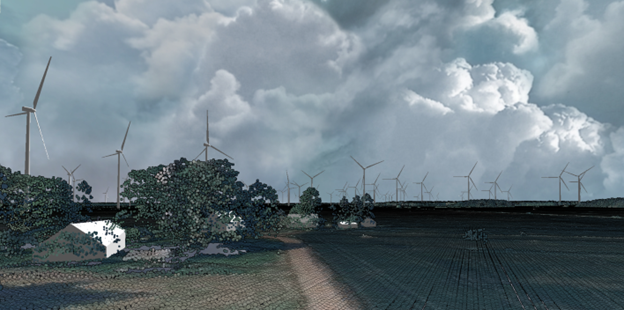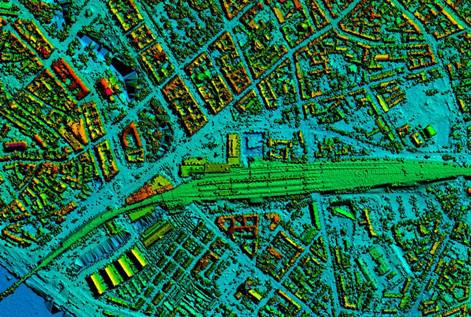ANALYSIS OF WIND PARK DEVELOPMENT OPPORTUNITIES
We conduct an analysis of wind farm development opportunities for the customer’s planned wind farm development area.
Within the framework of the evaluation, in the context of the specific project, the areas that affect the planning of the location of the wind farms are examined and analyzed – the restrictions set in the regulatory acts and the local government in the territorial development planning documents, protected natural areas and other encumbrances that affect the possibilities of the planned wind farm location.
METRUM has developed the geographic data management platform pgis.lv, where it is possible to accumulate, display and publish geospatial data. The METRUM geographic data management platform provides opportunities to spatially display the planned wind farm development area and various influencing factors – high-voltage power lines, functional zones defined in the territory plan, lanes around residential and public buildings, where the placement of wind farms is prohibited, protected natural areas and other encumbrances.
As part of the evaluation, we are analyzing whether the planned wind farm territory complies with 30.04.2013. The requirements and restrictions for the placement of wind farms specified in the Cabinet of Ministers Regulation No. 240 “General regulations for planning, use and construction of the territory” (hereinafter – the Regulation of the Cabinet of Ministers No. 240). Rules of the MK No. 240 determine:
functional zones in which the placement of wind farms is allowed;
the restriction that the minimum distance of wind power plants with a capacity of more than 2 MW from the border of the wind park to residential and public buildings is at least 800 m.
We evaluate the rules and restrictions contained in the municipal territorial development planning documents and their impact on the possibility of developing a wind farm in the specific functional areas (municipal sustainable development strategy, territorial planning, thematic plans).
The municipality’s long-term development strategy is a municipality’s long-term territorial development planning document, which includes the municipality’s long-term development vision, strategic goals and development priorities. We analyze the long-term development vision – strategic goals and long-term priorities – defined in the municipality’s sustainable development strategy. Has the municipality emphasized support for renewable energy resources or set any restrictions and conditions for their planning. We evaluate the location of the planned wind farm territory in the perspective of the spatial development of the municipality and the relevant functional space guidelines and their impact on the planned development of the wind farm.
Municipal territory planning is a long-term territory development planning document of the municipality, which sets requirements for the use and construction of the territory, including functional zoning. As part of the research, we evaluate which functional zones the planned wind park territory includes, whether the construction of wind power plants and wind parks is allowed in them. We analyze the additional conditions for the construction of wind farms in the territory plan. Regulations of the Cabinet of Ministers No. 240 allow municipalities to determine areas where the construction of wind power plants is prohibited. Using this right, individual municipalities have defined territories with special regulations (TIN) where the construction of wind power plants is prohibited (for example, “Territory of scenic value” or “Territory where the construction of wind power plants with a capacity greater than 20 kW is prohibited”, by defining such territories and graphically representing a 2 km or 1.5 km wide strip around the borders of villages and towns, etc.).
Thematic planning is a planning document for the development of the municipality’s territory, which addresses specific issues related to the development of certain sectors or a specific topic (for example, the location of engineering networks, areas of scenic value and risk areas). As part of the research, we assess whether the development area of the wind park is not defined as a landscape area of high scenic value in the thematic planning of the municipality, or whether there are restrictions on the construction of wind power plants and wind parks.
- We graphically depict and analyze the location of protected natural areas in the planned wind park territory or in the immediate vicinity and the possible impact on the development of the park – specially protected natural areas, natural monuments, micro-reserves, specially protected biotopes and habitats of protected species. We analyze the requirements for the protection of specially protected natural areas, which are defined in regulatory acts.
- We evaluate protective belts and other obstacles that limit the development possibilities of the wind farm: the coastal protective belt of the Baltic Sea and the Gulf of Riga, protective belts of surface water objects, protective belts around cultural monuments, operational protective belts around roads and railways, along electrical networks, technical means of navigation, military marine surveillance technical funds and other protective belts and encumbrances.
- Some local governments have determined in their territorial plans that a detailed plan must be developed before the construction of wind power plants or wind parks. In such cases, we provide proposals for the next steps – we prepare an application for making a decision on starting the development of a detailed plan, prepare a detailed plan, organize public discussion of the project, coordination with institutions and approval. As part of the development of the detailed plan, a construction project with a minimum composition can be developed. The further development of the construction plan takes place in accordance with the regulatory enactments governing construction after the entry into force of the detailed plan.
- We are planning a detailed arrangement of the wind power plant and the required set of engineering structures for the part of the wind park research territory that is outside the areas of wind park construction restrictions specified in the national regulatory acts or the municipal territorial planning.
We plan and spatially represent the location of wind power plants, taking into account the diameter of the rotor, the boundaries of land units and the distance between wind power plants. We plan wind power plant access roads, crew areas, transformer substations, electric cables and the location of other engineering structures.



Reviews
There are no reviews yet.